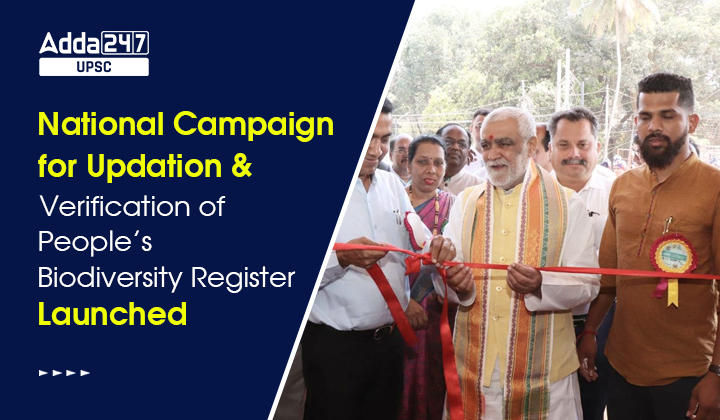Table of Contents
People’s Biodiversity Register: The People’s Biodiversity Register (PBR) refers to a comprehensive documentation of local biodiversity in a specific area, created with the active participation and knowledge of local communities. It is a tool for the conservation and sustainable management of biological resources at the grassroots level. People’s Biodiversity Register (PBR) is also important for UPSC Prelims Exam and UPSC Mains Exam (GS Paper 3- Environment and Ecology).
People’s Biodiversity Register in News
Recently, the National Campaign for Updation and Verification of the People’s Biodiversity Register (PBR) was inaugurated in Goa, representing a notable milestone in the documentation and conservation of India’s abundant biological diversity.
National Campaign for Updation and Verification of People’s Biodiversity Register
National Campaign for Updation and Verification of People’s Biodiversity Register was organized by the Union Ministry of Environment, Forest and Climate Change, in association with the Goa State Biodiversity Board, the National Biodiversity Authority, and the Government of Goa, witnessed the presence of esteemed dignitaries.
- So far 2,67,608 People’s Biodiversity Registers (PBR) have been prepared in the country, by Biodiversity Management Committees entrusted with the crucial task of documenting natural resources and traditional knowledge associated with them.
- Progress is also being made in digitizing the People’s Biodiversity Registers, transforming them into e-PBR.
- The Exercises such as preparation and updation of PBRs are also an integral part of the philosophy of Mission LiFE that was introduced by Prime Minister Narendra Modi at COP26 in Glasgow on November 1, 2021.
- LiFE concept calls upon individuals and institutions globally to promote mindful and deliberate utilization of resources to protect and preserve the environment.
People’s Biodiversity Register (PBR) Details
The People’s Biodiversity Register serves as a comprehensive record of various aspects of biodiversity, including the conservation of habitats, preservation of land races, folk varieties and cultivars, domesticated stocks and breeds of animals, micro-organisms, and the accumulation of knowledge related to the area’s biological diversity.
- As per the Biological Diversity Act 2002, Biodiversity Management Committees (BMC) are created for “promoting conservation, sustainable use and documentation of biological diversity” by local bodies across the country.
- BMCs have been constituted by the local bodies in the States and Union Territories and are entrusted with preparation of the People’s Biodiversity Registers (PBRs), in consultation with local communities.
- The PBR is typically developed through participatory processes involving local communities, indigenous peoples, and relevant stakeholders. It serves as a valuable resource for decision-makers, researchers, and policymakers to make informed decisions regarding biodiversity conservation, land-use planning, and sustainable development.
People’s Biodiversity Register (PBR) Objectives
The People’s Biodiversity Register (PBR) has the following key objectives-
- Documentation of Biodiversity: The primary objective of the PBR is to document and record the biodiversity present in a specific area, including plants, animals, microorganisms, and other ecological components. It aims to create a comprehensive inventory of the local biodiversity.
- Conservation and Sustainable Use: The PBR seeks to promote the conservation and sustainable use of biological resources by recording traditional knowledge, indigenous practices, and community-based management systems. It helps in identifying areas of ecological importance and developing strategies for their protection and sustainable management.
- Preservation of Traditional Knowledge: The PBR aims to capture and preserve the traditional knowledge and practices of local communities regarding biodiversity. It recognizes the valuable contributions of indigenous and traditional knowledge systems to biodiversity conservation and sustainable development.
- Community Participation and Empowerment: The PBR involves active participation and engagement of local communities, empowering them to contribute to biodiversity conservation efforts. It recognizes the rights and role of communities in managing their natural resources and promotes community-based initiatives for biodiversity protection.
- Support for Decision-Making and Policy Formulation: The information gathered in the PBR serves as a valuable resource for decision-makers, researchers, and policymakers. It provides scientific and community-based data that can inform conservation policies, land-use planning, and sustainable development strategies.
Conclusion
The People’s Biodiversity Register revolves around promoting biodiversity conservation, recognizing traditional knowledge, empowering local communities, and providing a foundation for evidence-based decision-making and policy formulation.
Climate Change on Wildlife: A Threat to Biodiversity and Ecosystems
Climate Change on Wildlife: A Threat to Biodiversity and Ecosystems



 TSPSC Group 1 Question Paper 2024, Downl...
TSPSC Group 1 Question Paper 2024, Downl...
 TSPSC Group 1 Answer key 2024 Out, Downl...
TSPSC Group 1 Answer key 2024 Out, Downl...
 UPSC Prelims 2024 Question Paper, Downlo...
UPSC Prelims 2024 Question Paper, Downlo...
